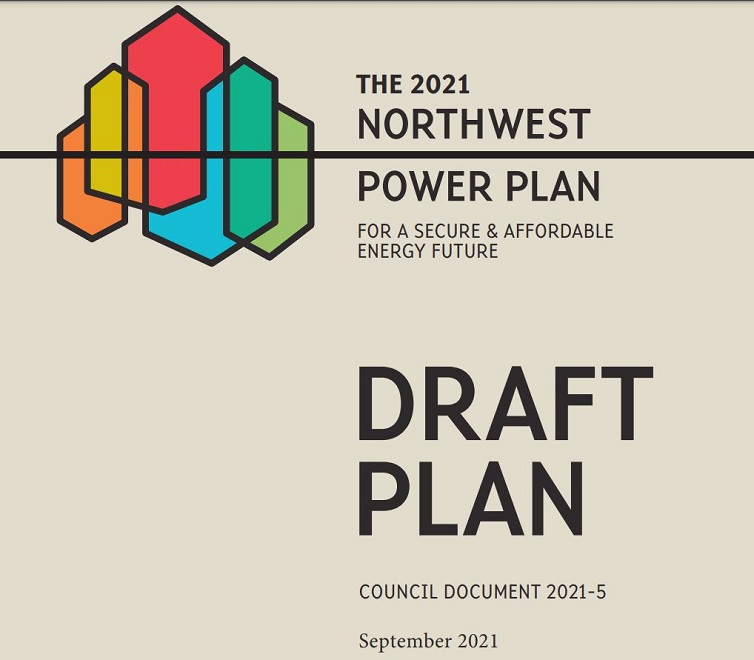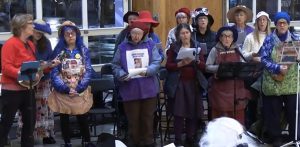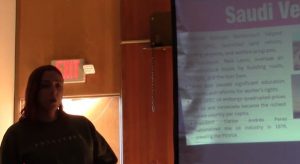Public to NW Council: Add offshore wind, hydrogen, storage, and grid resiliency
6 min read
Oregonians asked for more on storage, grid resiliency, offshore wind, and hydrogen.
Oregonians commented on the Northwest Power and Conservation Council’s draft power plan.
[00:00:05] Craig Patterson: My name is Craig Patterson, and I’m here representing the grandfather’s perspective. I really started my involvements in conservation 54 years ago when I built a geodesic dome and studied R. Buckminster Fuller, who talked about ‘Less is more.’ And I’ve followed that throughout my life. We recognize in conservation that we have been focusing on the low-hanging fruit, lighting and other things, and that the weatherization gap with people who have maybe low-income but are high users because their housing stock is very substandard, needs to be addressed. But how do we address it with the current system?
The other thing about conservation I think that has to be addressed is, that 98% of our conservation programs are deemed or projected savings. They’re not verified after the fact. And I think part of the confusion is between energy efficiency and conservation. Conservation means using less; energy efficiency means using less for a particular source, but not necessarily overall using less. Organized markets I think are the key here. If we organize the markets around conservation and charge for excessive consumption and put that extra revenue to conservation, it could be a win-win for everybody.
Thank you for supporting
local citizen journalism
[00:01:41] Shannon Souza, Oregon Coast Energy Alliance Network: My name is Shannon Souza, and I’m talking to you today from Allegany, Oregon, a small community about 10 miles upriver from Coos Bay, where I have for the past 25 years raised my family and run my business. At Oregon Coast Energy Alliance Network (OCEAN), we have a mission to explore the opportunities and challenges of floating offshore wind and other advanced clean energy technologies for coastal Oregonians. We reside at the Southwestern end of the BPA line and are completely reliant on imported energy to meet our most basic human needs. Our transmission corridors navigate catastrophe-prone routes, which often results in poor-quality power and frequent service interruptions to our isolated coastal communities.
We’d like to highlight the notable absence of floating offshore wind as a proxy for emerging technology in this plan. Floating offshore wind has been successfully deployed globally and off the shores of Scotland has demonstrated its ability to not only withstand hurricane forces, but to continue to supply clean, secure electrons to the island communities enduring those very same forces. Next week, the BOEM (Bureau of Ocean Energy Management) Oregon Offshore Wind Task Force will hold its ninth meeting as it prepares to issue an RFI to the global development community for areas of interest for lease and development off of Oregon’s shores in early 2022. Earlier this year Oregon’s house Bill 3375 established the planning goal for the inclusion of up to three gigawatts of offshore wind by 2030 onto our existing transmission system. The Oregon Clean Energy Pathways analysis released in June of this year finds that in all scenarios, 20 gigawatts of Oregon offshore wind will be developed by 2050 to support the entire Western grid. In short, we urge Council and staff to consider the acceleration of offshore wind inclusion in your planning efforts.
Please consider the inclusion of grid resilience at the community level in subsequent planning endeavors. Surely the megafires and ice storms—that have more recently expanded the footprint of those learning to live without energy— have underscored the urgency of this necessary update to our planning and valuation toolkit.
[00:04:20] Eugene Rosolie, Northwest Environmental Advocates: Eugene Rosolie and I am representing Northwest Environmental Advocates and NWEA has been around for well over 50 years now. We got formed in 1969 to oppose the operation and construction of the Trojan nuclear power plant. I would just mention, I think that the idea of micro grids and distributed generations needs more attention from the Council, if we’re talking about building resiliency for the grid.
[00:04:52] Bryce Yonker, Grid Forward: Hi, my name is Bryce Yonker, I’m the executive director of an organization called Grid Forward. We appreciate the inclusion of resiliency in the plan. However, two paragraphs on such a significant topic we believe are not sufficient. Just look at the last 12 months—we’ve had record-breaking heat events. We’ve had record-breaking outages from a winter storm. We have a looming threat from a significant earthquake with maybe a tsunami. Wildfires have ravaged the region. Fortunately for us cyber attacks didn’t impact this region, but they impacted the country. And this is just in the last handful of months. The region needs to significantly consider the implications of high-impact what are becoming increasingly-probable events. And we would encourage the Council to put this analysis into the plan.
[00:05:44] Michelle Detwiler, Renewable Hydrogen Alliance: Thank you for the opportunity to come in today on the draft 2021 Northwest power plan. My name is Michelle Detwiler, and I’m the executive director of the Renewable Hydrogen Alliance in Portland, Oregon. With over 75 members, RHA promotes the use of renewable electricity to produce hydrogen and other carbon neutral fuels.
RHA agrees and supports inclusion for the first time of hydrogen related technology and its potential as an, as a clean energy resource, but there is no discussion of the potential value of hydrogen as a renewable electricity storage medium. In fact, there is no discussion of any type of storage. Despite the fact that renewables plus storage systems are already under development in the region. In fact, the USDOE recognizes renewable hydrogen storage is a multifaceted management tool and enhancing flexibility and reliability of the electrical grid. We believe in added value is it could increase the effective capacity of wind, solar, and hydro resources.
[00:06:43] Kurt Miller, Northwest River Partners: My name is Kurt Miller. I’m the executive director of Northwest River Partners. We advocate for the role of hydro-power for a better civic Northwest. the council must make a clear and powerful statement on the necessity of maintaining all our productive, existing hydro-power resources, including the lower Snake River dams. This call-out is especially important in light of recent calls to breech the lower Snake River dams, and litigation on behalf of some state agencies that greatly diminish the energy capabilities and capacity of the lower Snake River dams and the lower Columbia River dams. If plaintiffs in the current federal case get their way, the council’s power plan risks becoming obsolete shortly after it’s released.
[00:07:29] Dan Kirschner, Northwest Gas Association: My name is Dan Kirschner. I’m the executive director of the Northwest Gas Association. The Gas Association represents the six natural gas utilities and the three interstate natural gas pipelines that serve 3.2 million residents. Our members own and operate 130,000 miles of pipeline across our footprint. If you had Montana into that, it’s closer to 145,000 miles of pipeline system. This is a pipeline system that can be repurposed and used in different ways, including as storage—an energy storage resource. With a three-million-mile interconnected pipeline network across North America, we can access renewable natural gas and renewable hydrogen from other areas of the country.
[00:08:41] Fred Huette, Northwest Energy Coalition: My name is Fred Huette. I live in Portland, Oregon, and I’m speaking on behalf of the Northwest Energy Coalition. The Northwest Power Act five-year planning cycle remains the council’s core responsibility. However, going forward, we foresee a broadening of the council’s activity. The 2021 plan can be a starting point for new collaborative regional efforts to identify a comprehensive, balanced, and secure decarbonization pathway forward. This will fully engage the council’s assets—its irreplaceable repository of data and technical assessment and the range of experience and insights of council members, staff, and stakeholders—to further modernize the counsel’s modeling resources to better reflect the dynamic nature of the resources used in the region.





